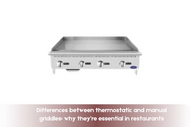Differences between thermostatic and manual griddles: why they’re essential in restaurants
When it comes to commercial restaurant equipment, selecting between a thermostatic griddle and a manual griddle can significantly impact cooking consistency, kitchen efficiency, and food quality. Whether searching for restaurant equipment Dallas or even used restaurant equipment Dallas, here’s a clear, focused guide to help you decide which griddle is best.
What is a manual griddle?
A manual griddle (non‑thermostatic) uses simple controls: knobs that adjust flame or electric heat to settings like low, medium, or high. There's no exact temperature control—the chef must monitor and adjust in real time by feel and observation .
Pros of manual griddles:
-
Lower upfront cost in your commercial restaurant equipment budget.
-
Simple, fewer mechanical parts, easier repairs.
-
Ideal for operations that cook the same type of food repeatedly (e.g., tortillas, hot dogs, burgers) .
-
Allows experienced cooks to have intuitive control.
Cons:
-
Requires continuous attention—dropping cold food drops surface temperature, and you must adjust.
-
Higher training burden for new staff.
-
Temperature consistency suffers during busy shifts .
What is a thermostatic griddle?
A thermostatic griddle lets you dial in an exact temperature (e.g. 350 °F) and automatically maintains it by adjusting gas or electricity input .
Types of thermostatic controls:
-
Modulating (throttling): provides constant flame with variable gas flow; maintains within ± 30‑40 °F. Budget-friendly but slower at heat recovery under heavy loads .
-
Snap‑action: on/off cycles maintain within ± 10‑15 °F, faster recovery—excellent for high-volume kitchens .
-
Solid‑state embedded: highest precision, within ± 5 °F, ultra-responsive, ideal for premium or delicate foods like seafood or steaks .
Why these griddles matter in restaurants
Consistency and food quality
Restaurants using restaurant equipment Dallas serve eggs, pancakes, burgers, and more throughout the day. A thermostatic griddle ensures every item cooks at consistent temperature, improves quality, reduces waste .
Operational efficiency
-
Thermostatic griddles allow seamless transitions between cooking styles (e.g., high temp for searing, low temp for warming) without constant monitoring.
-
Manual griddles need manual flame adjustment—if operators don’t catch the change in time after cold loading, results vary .
-
With variable experience in chefs or high turnover, thermostatic control helps maintain standards.
Energy savings & reduced waste
Thermostatic units only call for heat when needed to sustain temperature, cutting energy consumption. Consistent cooking also avoids burnt or under-done food, reducing product waste and saving money long-term .
Maintenance and durability
-
Manual control griddles are simpler, fewer failure points.
-
Thermostatic units can be very durable if properly maintained.
-
Plate material and thickness matter:
-
Thick plates (¾-inch to 1-inch) offer better heat retention, resist warping, and handle high-volume workloads .
-
Chrome-finished plates are easy to clean, don’t retain flavors, reduce kitchen heat, and may lower utility use .
-
Choosing between manual and thermostatic griddles: use cases
Manual griddle suited for:
-
Uniform cooking tasks, minimal menu variety.
-
Tight budget operations.
-
Trained chefs comfortable with manual control.
-
Examples: taco stands, hot dog carts, high-throughput burger stations.
Thermostatic griddle suited for:
-
Varied menus: breakfast foods, burgers, seafood, grilled items.
-
Fast-paced kitchens with rotating staff or less experienced cooks.
-
Need for consistent quality, timing, and reduced oversight.
-
Valuable option even in the used restaurant equipment Dallas market; higher resell value.
Tips for buying restaurant equipment Dallas or used restaurant equipment Dallas
-
Define your operation style: For breakfast-focused or burger-heavy menus, a snap‑action thermostatic griddle is efficient. For single-menu operations, a manual griddle is workable.
-
Check plate thickness: For volume cooking, aim for ¾″ or 1″ thickness whether new or used restaurant equipment Dallas.
-
Inspect used units carefully: test thermostat function, clean condition, burner or element performance.
-
Know the control type: throttling vs snap‑action vs solid‑state, and confirm it’s working correctly.
-
Choose trusted brands with local support: in Dallas area, availability of service and parts matters.
Summary
-
Manual griddles bring simplicity and lower cost—but require chef expertise and constant attention.
-
Thermostatic griddles offer precision, consistency, energy savings, and lower oversight—ideal for diverse menus and busy kitchens.
-
In commercial restaurant equipment decisions—new or used restaurant equipment Dallas—investing in a thermostatic griddle often pays off through quality, efficiency, and resale potential.
-
Key considerations: plate thickness, thermostat type, brand support, and intended usage.

